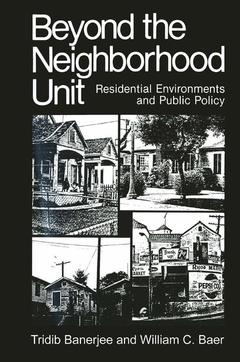Description
Beyond the Neighborhood Unit, Softcover reprint of the original 1st ed. 1984
Residential Environments and Public Policy
Environment, Development and Public Policy: Environmental Policy and Planning Series
Authors: Banerjee Tridib, Baer William C.
Language: English
Subjects for Beyond the Neighborhood Unit:
Keywords
Design; Kredit; Nation; Policy; education; environment; environmental management; management
Approximative price 158.24 €
In Print (Delivery period: 15 days).
Add to cart
Publication date: 04-2013
253 p. · 15.2x22.9 cm · Paperback
253 p. · 15.2x22.9 cm · Paperback
Description
/li>Contents
/li>
Much of the research on which this book is based was funded almost a decade ago by separate grants from two different agencies of the U. S. Public Health Service, of the then still consolidated Department of Health, Education, and Welfare. The first grant was from the Bureau of Community Environmental Management (Public Health Service Research Grant J-RO J EM 0049-02), and the second from the Center for Studies of Metropolitan Problems of the National Institute of Mental Health (Public Health Service Grant ROJ MH 24904-02). These separate grants were necessary because of budget cuts that truncated our original effort. We were fortunate to receive subsequent assistance from NIMH to conclude the research, as it is doubtful that a project of the scope and intent of our effort--even as completed in abbreviated form-will be funded in the 1980s. The original intent of this project, as formulated by our colleagues Ira Robinson and Alan Kreditor, and as conceptualized earlier by their predeces sors-members of an advisory committee of planners and social scientists ap pointed by the American Public Health Association (APHA)-was to rewrite Planning the Neighborhood, APHA's recommended standards for residential design. In particular, it was proposed that the new study take the point of view of the user in terms of residential standards. Hitherto, the private sector had domi nated these considerations (i. e. , the designer's predilections, the requirements of builders and material suppliers, and lenders' needs for mortgage security).
1. Introduction.- 2. The Neighborhood Unit as a Design Paradigm.- 3. The Research Instrument and Respondent Impressions of the Residential Environment.- 4. Residential Area and Neighborhood: Images and Values.- 5. Residential Area as a Physical Place: The Setting.- 6. Taking Stock: A Synthesis of the Findings.- 7. Toward a New Design Paradigm.- References.- Appendix I: Survey Questionnaire.- Appendix II: Supplementary Tables.
© 2024 LAVOISIER S.A.S.




